Akram Shafie
On the Time-Frequency Localization Characteristics of the Delay-Doppler Plane Orthogonal Pulse
Dec 14, 2024



Abstract:In this work, we study the time-frequency (TF) localization characteristics of the prototype pulse of orthogonal delay-Doppler (DD) division multiplexing modulation, namely, the DD plane orthogonal pulse (DDOP). The TF localization characteristics examine how concentrated or spread out the energy of a pulse is in the joint TF domain, the time domain (TD), and the frequency domain (FD). We first derive the TF localization metrics of the DDOP, including its TF area, its time and frequency dispersions, and its direction parameter. Based on these results, we demonstrate that the DDOP exhibits a high energy spread in the TD, FD, and the joint TF domain, while adhering to the Heisenberg uncertainty principle. Thereafter, we discuss the potential advantages brought by the energy spread of the DDOP, especially with regard to harnessing both time and frequency diversities and enabling fine-resolution sensing. Subsequently, we examine the relationships between the time and frequency dispersions of the DDOP and those of the envelope functions of DDOP's TD and FD representations, paving the way for simplified determination of the TF localization metrics for more generalized variants of the DDOP and the pulses used in other DD domain modulation schemes. Finally, using numerical results, we validate our analysis and find further insights.
Channel Spreading Function-Inspired Channel Transfer Function Estimation for OFDM Systems with High-Mobility
Dec 10, 2024


Abstract:In this letter, we propose a novel channel transfer function (CTF) estimation approach for orthogonal frequency division multiplexing (OFDM) systems in high-mobility scenarios, that leverages the stationary properties of the delay-Doppler domain channel spreading function (CSF). First, we develop a CSF estimation model for OFDM systems that relies solely on discrete pilot symbols in the time-frequency (TF) domain, positioned at predefined resource elements. We then present theorems to elucidate the relationship between CSF compactness and pilot spacing in the TF domain for accurate CSF acquisition. Based on the estimated CSF, we finally estimate the CTF for data symbols. Numerical results show that, in high-mobility scenarios, the proposed approach outperforms traditional interpolation-based methods and closely matches the optimal estimator in terms of estimation accuracy. This work may pave the way for CSF estimation in commercial OFDM systems, benefiting high-mobility communications, integrated sensing and communications, and related applications.
Off-grid Channel Estimation for Orthogonal Delay-Doppler Division Multiplexing Using Grid Refinement and Adjustment
Jul 09, 2024Abstract:Orthogonal delay-Doppler (DD) division multiplexing (ODDM) has been recently proposed as a promising multicarrier modulation scheme to tackle Doppler spread in high-mobility environments. Accurate channel estimation is of paramount importance to guarantee reliable communication for the ODDM, especially when the delays and Dopplers of the propagation paths are off-grid. In this paper, we propose a novel grid refinement and adjustment-based sparse Bayesian inference (GRASBI) scheme for DD domain channel estimation. The GRASBI involves first formulating the channel estimation problem as a sparse signal recovery through the introduction of a virtual DD grid. Then, an iterative process is proposed that involves (i) sparse Bayesian learning to estimate the channel parameters and (ii) a novel grid refinement and adjustment process to adjust the virtual grid points. The grid adjustment in GRASBI relies on the maximum likelihood principle to attain the adjustment and utilizes refined grids that have much higher resolution than the virtual grid. Moreover, a low-complexity grid refinement and adjustment-based channel estimation scheme is proposed, that can provides a good tradeoff between the estimation accuracy and the complexity. Finally, numerical results are provided to demonstrate the accuracy and efficiency of the proposed channel estimation schemes.
Time-Frequency Localization Characteristics of the Delay-Doppler Plane Orthogonal Pulse
Nov 13, 2023Abstract:The orthogonal delay-Doppler (DD) division multiplexing (ODDM) modulation has recently been proposed as a promising solution for ensuring reliable communications in high mobility scenarios. In this work, we investigate the time-frequency (TF) localization characteristics of the DD plane orthogonal pulse (DDOP), which is the prototype pulse of ODDM modulation. The TF localization characteristics examine how concentrated or spread out the energy of a pulse is in the joint TF domain. We first derive the TF localization metric, TF area (TFA), for the DDOP. Based on this result, we provide insights into the energy spread of the DDOP in the joint TF domain. Then, we delve into the potential advantages of the DDOP due to its energy spread, particularly in terms of leveraging both time and frequency diversities, and enabling high-resolution sensing. Furthermore, we determine the TFA for the recently proposed generalized design of the DDOP. Finally, we validate our analysis based on numerical results and show that the energy spread for the generalized design of the DDOP in the joint TF domain exhibits a step-wise increase as the duration of sub-pulses increases.
Coexistence of OTFS Modulation With OFDM-based Communication Systems
Nov 12, 2023Abstract:This study examines the coexistence of orthogonal time-frequency space (OTFS) modulation with current fourth- and fifth-generation (4G/5G) wireless communication systems that primarily use orthogonal frequency-division multiplexing (OFDM) waveforms. We first derive the input-output-relation (IOR) of OTFS when it coexists with an OFDM system while considering the impact of unequal lengths of the cyclic prefixes (CPs) in the OTFS signal. We show analytically that the inclusion of multiple CPs to the OTFS signal results in the effective sampled delay-Doppler (DD) domain channel response to be less sparse. We also show that the effective DD domain channel coefficients for OTFS in coexisting systems are influenced by the unequal lengths of the CPs. Subsequently, we propose an embedded pilot-aided channel estimation (CE) technique for OTFS in coexisting systems that leverages the derived IOR for accurate channel characterization. Using numerical results, we show that ignoring the impact of unequal lengths of the CPs during signal detection can degrade the bit error rate performance of OTFS in coexisting systems. We also show that the proposed CE technique for OTFS in coexisting systems outperforms the state-of-the-art threshold-based CE technique.
Terahertz Communications for Massive Connectivity and Security in 6G and Beyond Era
Oct 25, 2022



Abstract:Terahertz (THz) communications (THzCom) has experienced a meteoric rise of interest, due to its benefits for ultra-high data rate transmission in the sixth generation (6G) and beyond era. Despite so, the research on exploring the potential of THzCom for other performance targets anticipated by 6G, including massive connectivity and security, is still in its infancy. In this article, we start with briefly describing the unique peculiarities of THz channels, and then discuss theoretical frameworks to facilitate the analysis and design of THz transmission for achieving massive connectivity and security. Then we discuss promising spectrum management strategies, including the exploration of multiple THz transmission windows and frequency reuse with multiplexing and signal processing, to substantially increase the number of supported users and identify to-be-tackled challenges. We further present important research directions based on the principles of physical layer security, such as new spectrum allocation policies and beamforming algorithms, to fight against eavesdropping in THzCom systems, ushering in secure THzCom systems.
An Unsupervised Learning Approach for Spectrum Allocation in Terahertz Communication Systems
Aug 07, 2022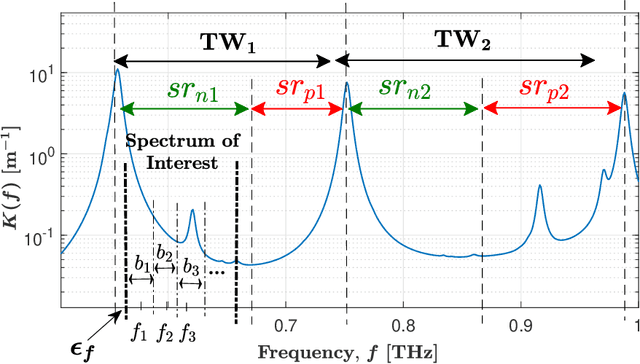
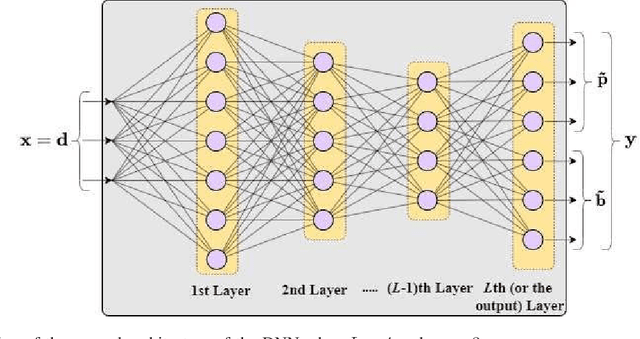

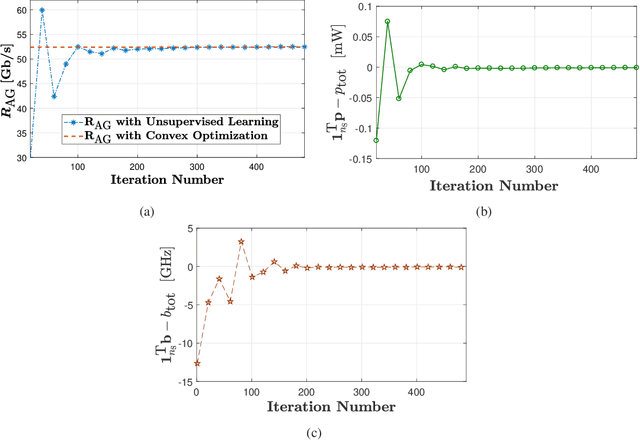
Abstract:We propose a new spectrum allocation strategy, aided by unsupervised learning, for multiuser terahertz communication systems. In this strategy, adaptive sub-band bandwidth is considered such that the spectrum of interest can be divided into sub-bands with unequal bandwidths. This strategy reduces the variation in molecular absorption loss among the users, leading to the improved data rate performance. We first formulate an optimization problem to determine the optimal sub-band bandwidth and transmit power, and then propose the unsupervised learning-based approach to obtaining the near-optimal solution to this problem. In the proposed approach, we first train a deep neural network (DNN) while utilizing a loss function that is inspired by the Lagrangian of the formulated problem. Then using the trained DNN, we approximate the near-optimal solutions. Numerical results demonstrate that comparing to existing approaches, our proposed unsupervised learning-based approach achieves a higher data rate, especially when the molecular absorption coefficient within the spectrum of interest varies in a highly non-linear manner.
Terahertz Communications for 6G and Beyond Wireless Networks: Challenges, Key Advancements, and Opportunities
Jul 22, 2022
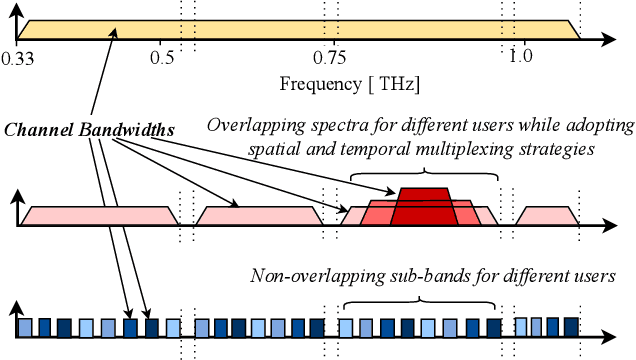
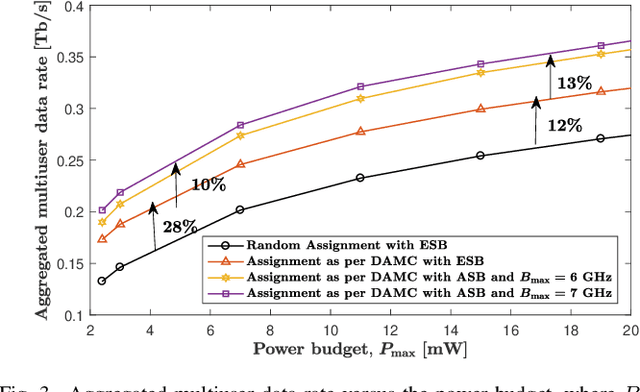
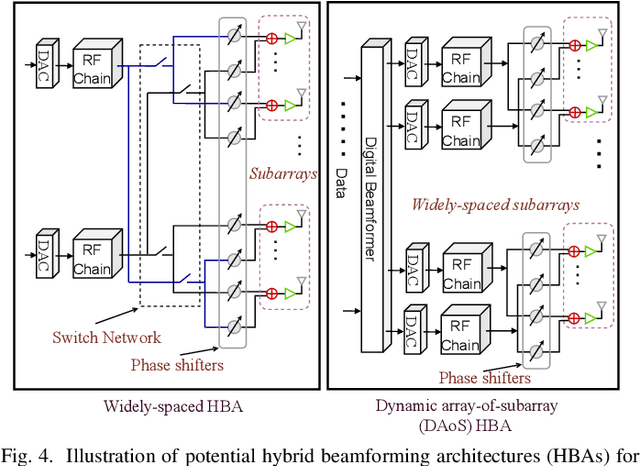
Abstract:The unprecedented increase in wireless data traffic, predicted to occur within the next decade, is motivating academia and industries to look beyond contemporary wireless standards and conceptualize the sixth-generation (6G) wireless networks. Among various promising solutions, terahertz (THz) communications (THzCom) is recognized as a highly promising technology for the 6G and beyond era, due to its unique potential to support terabit-per-second transmission in emerging applications. This article delves into key areas for developing end-to-end THzCom systems, focusing on physical, link, and network layers. Specifically, we discuss the areas of THz spectrum management, THz antennas and beamforming, and the integration of other 6G-enabling technologies for THzCom. For each area, we identify the challenges imposed by the unique properties of the THz band. We then present main advancements and outline perspective research directions in each area to stimulate future research efforts for realizing THzCom in 6G and beyond wireless networks.
Novel Spectrum Allocation Among Multiple Transmission Windows for Terahertz Communication Systems
Jul 06, 2022

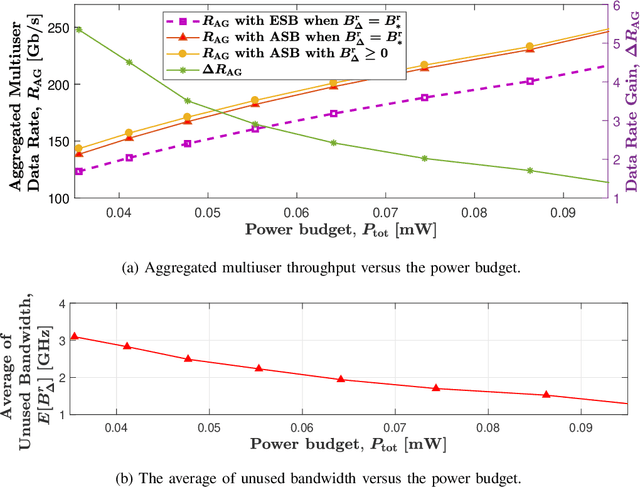

Abstract:This paper presents a novel spectrum allocation strategy for multiuser terahertz (THz) band communication systems when the to-be-allocated spectrum is composed of multiple transmission windows (TWs). This strategy explores the benefits of (i) allowing users to occupy sub-bands with unequal bandwidths and (ii) optimally avoiding using some spectra that exist at the edges of TWs where molecular absorption loss is high. To maximize the aggregated multiuser data rate, we formulate an optimization problem, with the primary focus on spectrum allocation. We then apply transformations and modifications to make the problem computationally tractable, and develop an iterative algorithm based on successive convex approximation to determine the optimal sub-band bandwidth and the unused spectra at the edges of TWs. Using numerical results, we show that a significantly higher data rate can be achieved by changing the sub-band bandwidth, as compared to equal sub-band bandwidth. We also show that a further data rate gain can be obtained by optimally determining the unused spectra at the edges of TWs, as compared to avoiding using pre-defined spectra at the edges of TWs.
Spectrum Allocation with Adaptive Sub-band Bandwidth for Terahertz Communication Systems
Nov 10, 2021
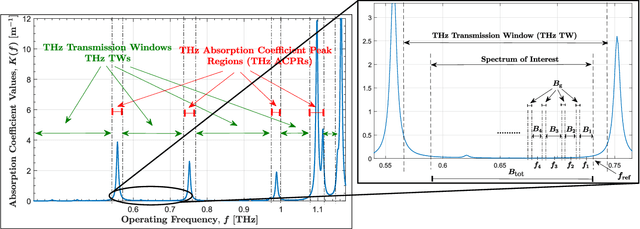
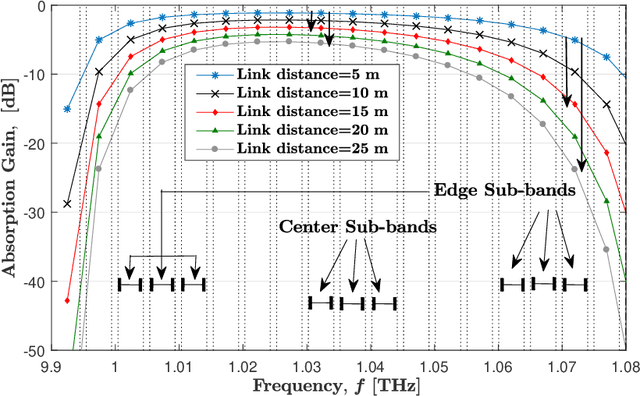
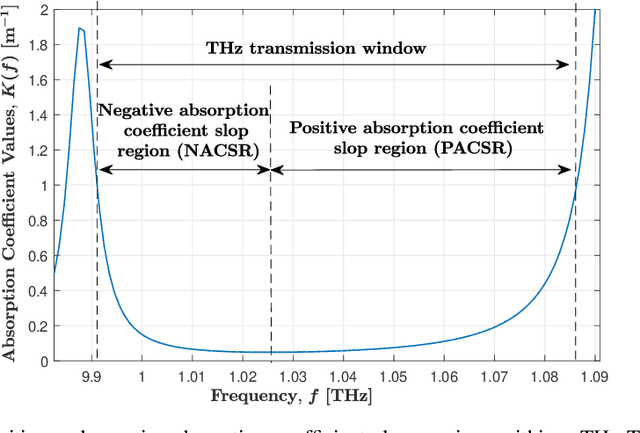
Abstract:We study spectrum allocation for terahertz (THz) band communication (THzCom) systems, while considering the frequency and distance-dependent nature of THz channels. Different from existing studies, we explore multi-band-based spectrum allocation with adaptive sub-band bandwidth (ASB) by allowing the spectrum of interest to be divided into sub-bands with unequal bandwidths. Also, we investigate the impact of sub-band assignment on multi-connectivity (MC) enabled THzCom systems, where users associate and communicate with multiple access points simultaneously. We formulate resource allocation problems, with the primary focus on spectrum allocation, to determine sub-band assignment, sub-band bandwidth, and optimal transmit power. Thereafter, we propose reasonable approximations and transformations, and develop iterative algorithms based on the successive convex approximation technique to analytically solve the formulated problems. Aided by numerical results, we show that by enabling and optimizing ASB, significantly higher throughput can be achieved as compared to adopting equal sub-band bandwidth, and this throughput gain is most profound when the power budget constraint is more stringent. We also show that our sub-band assignment strategy in MC-enabled THzCom systems outperforms the state-of-the-art sub-band assignment strategies and the performance gain is most profound when the spectrum with the lowest average molecular absorption coefficient is selected during spectrum allocation.
 Add to Chrome
Add to Chrome Add to Firefox
Add to Firefox Add to Edge
Add to Edge